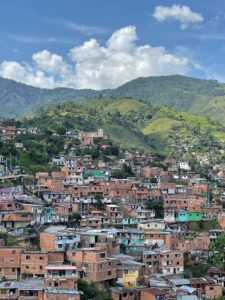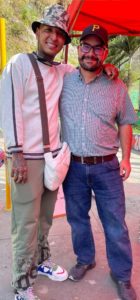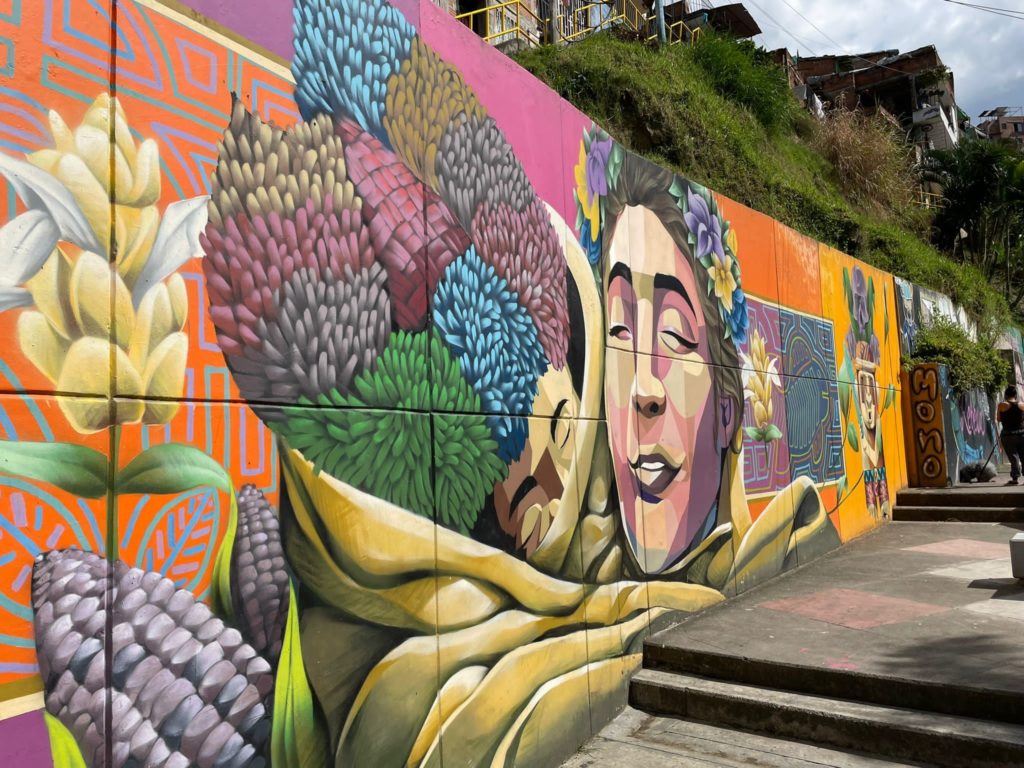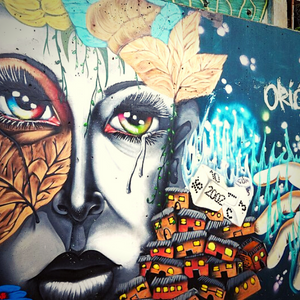After many COVID tests, vaccine shots and a booster, I was ready to travel for the recent academic break. After discussing our options, we decided to travel to Medellín, Colombia. After attending numerous family gatherings, we were able to escape one morning to visit Comuna 13, a neighbourhood in Medellín with an impressive history of conflict and peace.

Picture 1: One section of Comuna 13
Colombia’s decades-long armed conflict forced thousands of families to move from rural areas. Many of those escaping the conflict during the 1970s and 1980s moved to Comuna 13. This internal migration was massive, sudden and disorganised. The newcomers built houses one on top of the other in informal settlements in hills located in the outskirts of Medellín (see picture 1). There was little connection between the Comuna and the rest of the city. In fact, it is not possible to reach many parts of the Comuna by car. You can only get there using narrow corridors that are so steep that it would prove a challenge for many triathlon athletes. As such, the Comuna represented a population displaced by conflict, living in an isolated informal settlement.
Given the absence of any formal local government structure, several non-state armed groups, mainly guerrilla groups, took control of different parts of the Comuna. The youth in Comuna 13 represented an ideal demographic for guerrilla recruitment. Once the guerrilla groups took over, it meant that for many years Comuna 13 was effectively closed to outsiders, including Colombia’s Government. Comuna 13 became the most dangerous neighbourhood in a city that was already famous for being the most dangerous in the world.
The policy of the Colombian Government changed over time. A new “iron fist” policy was established against the guerrilla groups. This policy included taking over Comuna 13 at any human cost. The cost was indeed high, and the jury is out on whether it was worth it, but in the 2000s the control of the guerrilla groups over Comuna 13 ended. Instead, a combination of criminal gangs took control. Violence was still very high.
This all changed during the last decade as part of an internal process of peace negotiation among all opposing sides. A number of infrastructural innovations helped linked the Comuna to the city – for example a series of outdoors escalators were built meaning that those of us who are not triathlon athletes can go visit. Because of all of this, Comuna 13 is now one the main touristic attractions of Medellín.
Our guide, a man in his 40s, is a second generation resident of Comuna 13. His parents were displaced by the conflict, but he was born and bred in the Comuna. I have spent a lot of time in recent years exploring the employment patterns of forced migrants in different contexts, from the UK to Burundi and I asked him about this.

Picture 2: Rapza (who plays Riquelme in The Queen of Flow) and Carlos Vargas-Silva
Before the Comuna opened for tourism, he spent 18 years rapping in local buses. He explained that performing for tips was sufficient to support a family of five. He still dreams of becoming a well-known rapper, but considers that he still needs to accumulate some more “flow” before that. In addition, he is trying to save money for a video. He reckons that he would need about $500,000 (GBP £100) for a good video. He knows someone who could do it for $100,000 pesos (GBP £20), but does not want to take a chance on quality.
As I explained in the recent 2021 COMPAS Migration Book (etc.) Review, I spent many nights last year watching The Queen of Flow (171 episodes!), a telenovela about rappers in the comunas of Medellín. I mentioned this to our guide and he took me to a corner where Riquelme, one of the characters of the show, was performing. Our guide also claimed that Riquelme was one of his students in the rap business.
To my surprise, the story of Riquelme (his artistic name is Rapza) is very similar to that of his character in The Queen of Flow. He explained that he lives in the Comuna and raps for tips from tourists. Nowadays he also gets tips from tourists taking a picture with him (see picture 2).
In a recent interview, he explained how he got into the show. After hearing about a TV casting for a rapper with tattoos, he saved all the tips from singing in the street and bought a plane ticket for the audition. It was his first time flying on an airplane.
In addition to music, the other great attraction of Comuna 13 is graffiti. Most graffiti in the neighbourhood refers to the long history of displacement and violence experienced by its residents (see picture 3). Among the most popular graffiti artists is Chota_13. In addition, to a gallery with his paintings he owns a small café. The walls of the café are full of his pictures with different personalities that have visited it from Bill Clinton to reggaeton celebrities. We were so impressed with his art, that we bought one of his original paintings. Hence, if you are around Oxford and want to see his art without travelling all the way to Medellín, you are welcome to visit our living room any time.
As we were leaving, I met an older woman hanging clothes outside her house. I asked her about the changes in the neighbourhood over time. She summarised her sentiment very well: “it has always been hard. Moving here, dealing with the guerrillas, government attacks, criminal gangs and now all these tourists walking outside your house. It never ends for us …”

Picture 3: Graffiti in Comuna 13
